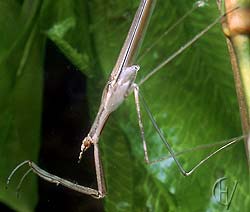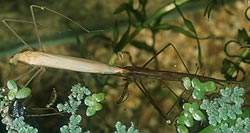The Water Stick Insect is the largest water insect in
Europe. You might think it would "stick out" with it's 4 centimeter length (7
centimeter including the breathing tube). But strange thing is, you easily overlook this
large bug in your dipping net, where it's taking a stiff and dead posture to mimic a
little stick; and with its legs pressed against the body you take it for a piece of old
reed. So, with the debris of water plants you scooped up, you unknowingly throw it back into
the water. The specimen of the photo surprised me by its sudden movement, otherwise I would
have done the same... It turned out to be a young specimen, its breathing tube still being
short.
During its stay in a little plastic bucket, to my disappointment it seemed to float
dead on the surface one day, by then I didn't know it was just the shed skin: it had
moulted. Later I saw the bug on the bottom, still pale, with the fullgrown breathing tube.
And it kept surprising me how, every time I wanted to take a peek, it seemed to have
disappeared between the water plants and only came in sight after I poked a little bit with
a small stick. It's a fascinating animal that easily grows up in an aquarium. I raised
up two from the larval state and put them back in their original pool. For a full grown
Water Stick Insect the tank must have a minimal height of 20 centimeters.
Very often you have to look hard to find the animal again, the picture on the left the animal is better visible because lighting and background are helping. In its habitat it hangs motionless between the Floating Pondweed stems (Potamogeton natans), by its long mid and hind legs which are held slanted backwards. There's the creatures favorite hiding spot, in the dim light it becomes a stalk itself and disappears from the view of its predators and prey. Very slowly it moves up backward until the long breathing tube touches the water surface. Almost unnoticeably the long, slender body then rises and sinks a millimeter with each breathing in and out, because of the difference in upward pressure. The front legs, the scythes of this Spirit of Death, are held ready for a greedy welcome. Like the front legs of the Water Scorpion the feet(tarsi) snap like a pocket knife in a groove in the thigh part (femur) and form a merciless trap, from which no insect leg ever gets free alive. They seem to close in an autonomic reflex. It appeared to me that small animals are trapped when they walk over the front legs, holding them for harmless stalks. It reminds me of a flesh-eating plant. This "silent vegetable" carnivore has risen stealth murder, the beloved way of gathering food in pond and ditch, to a high state of art. The reflex of the front legs harvests smaller animals, and when the eyes spot a bigger prey the Water Stick Insect moves very slow untill the target is in reach - and with a quick draw the game is seized.
Very often you have to look hard to find the animal again, the picture on the left the animal is better visible because lighting and background are helping. In its habitat it hangs motionless between the Floating Pondweed stems (Potamogeton natans), by its long mid and hind legs which are held slanted backwards. There's the creatures favorite hiding spot, in the dim light it becomes a stalk itself and disappears from the view of its predators and prey. Very slowly it moves up backward until the long breathing tube touches the water surface. Almost unnoticeably the long, slender body then rises and sinks a millimeter with each breathing in and out, because of the difference in upward pressure. The front legs, the scythes of this Spirit of Death, are held ready for a greedy welcome. Like the front legs of the Water Scorpion the feet(tarsi) snap like a pocket knife in a groove in the thigh part (femur) and form a merciless trap, from which no insect leg ever gets free alive. They seem to close in an autonomic reflex. It appeared to me that small animals are trapped when they walk over the front legs, holding them for harmless stalks. It reminds me of a flesh-eating plant. This "silent vegetable" carnivore has risen stealth murder, the beloved way of gathering food in pond and ditch, to a high state of art. The reflex of the front legs harvests smaller animals, and when the eyes spot a bigger prey the Water Stick Insect moves very slow untill the target is in reach - and with a quick draw the game is seized.
The prey is brought to the head, the short, flexible beak is thrusted into the victim,
which is then sucked out. I don't know whether the Water Stick Insect inflict a painful
nip to a human finger. Some articles say they may, but my specimen had no intention. During
its meal the bug is often capable of catching new prey in a free front leg. Non struggling
small prey is often kept on the beak without support of one of the front legs, so the Water
Stick insect sometimes carries three victims: one in each leg and one on the proboscis. It
may even catch two small animals simultaneously with the two legs! )¹
Some investigators think flies, that have fallen on the water surface are the stick-insect's main source of nutrition. They are good in catching them anyway: the bug stretches the supporting legs, so it bends slowly upwards, and with a quick haul the fly is dragged under water.
Mating is during springtime. The eggs are inserted into decomposing plants on the water surface. They are equipped with two wires that might have a role in air supply.
Some investigators think flies, that have fallen on the water surface are the stick-insect's main source of nutrition. They are good in catching them anyway: the bug stretches the supporting legs, so it bends slowly upwards, and with a quick haul the fly is dragged under water.
Mating is during springtime. The eggs are inserted into decomposing plants on the water surface. They are equipped with two wires that might have a role in air supply.
THE LARVA
As with all bugs the larva already resembles the perfect insect. They have a short breathing tube and still miss the wings. The body is spotted, this gives them camouflage between smaller water plants. No wonder I discovered this specimen only after some days in the aquarium. They are just as good in hunting as there parents and grow fast. After a few moults they are adult, the breathing tube is short until the very last molt.
As with all bugs the larva already resembles the perfect insect. They have a short breathing tube and still miss the wings. The body is spotted, this gives them camouflage between smaller water plants. No wonder I discovered this specimen only after some days in the aquarium. They are just as good in hunting as there parents and grow fast. After a few moults they are adult, the breathing tube is short until the very last molt.
WEBLINKS:
1) Article
about the simultaneous catching of two prey
2) Photo of a winged Water
Stick Insect (American species).

back to: WATERBUGS
Page track: INDEX » waterbugs » Water Stick Insect
COPYRIGHT:
All pictures on this site have been made by G.H. Visser
(Aadorp, Holland), unless otherwise mentioned. All rights remain with him. These
photo's may not be used for other then strictly private uses. In case you want to use
them for purposes including third parties, you MUST request permission, by e-mailing the author. I encourage especially those wanting to use the
pictures for nature-expositions or other educative targets.
© G.H. Visser 17-08-2007
rev. 25-03-2022
Deze pagina in het Nederlands
This page: https://www.microcosmos.nl/bugs2/ranatra.htm






